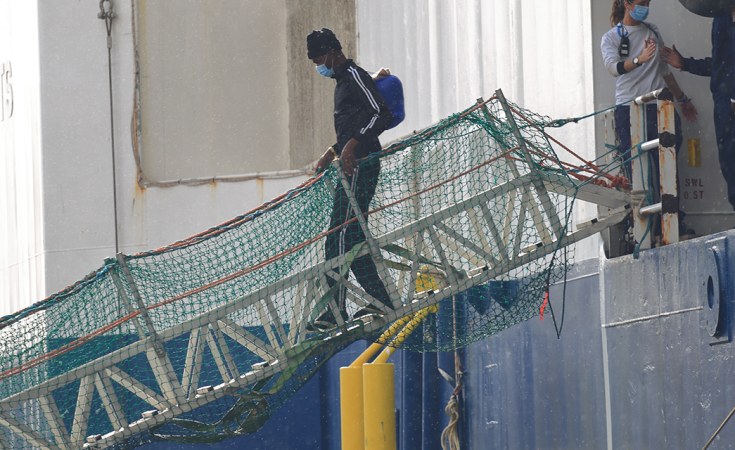As instability in the region grows, the EU's faltering strategy with partner countries should be adapted.
This year, a complex mix of insecurity, poverty and misgovernance has seen instability soar in the Sahel. Among the immediate effects is a rise in forced and voluntary migration from the region to other parts of Africa and towards Europe, which is difficult to contain.
According to Médecins Sans Frontières, 2023 has been the deadliest year on the Central Mediterranean migration route since 2017, with 2 480 deaths so far. Many people using this route are from Africa, with an increasing number since 2021 from Sahelian countries like Mali and Burkina Faso.
In response, Africa has focused on addressing the insecurity, while Europe is concerned about the increase in migration. Europe's approach has included entering into controversial bilateral deals with countries in and neighbouring the Sahel, including Libya and Tunisia. It's a thorny subject at a time when migration is high on the policy agenda of several European countries, like Greece, Italy, Netherlands and Germany.
Since 2015, the European Union (EU) and some of its member states have funded interventions aimed at strengthening Sahelian states' capacity to regulate and control migration - both as a source and a transit region. Examples include the EU Emergency Trust Fund for Africa in the Sahel, with Niger, Burkina Faso and Mali as the top beneficiaries.
Africa has focused on tackling insecurity, while Europe is concerned about the increase in migration
While the results have been varied, research by the Institute for Security Studies (ISS) and others shows they have been mostly negative. Insecurity and instability have increased, livelihoods have been disrupted, migration and smuggling routes have become more complex, and the social contract between states and the population has eroded. Some argue that the EU's migration approach has inadvertently fuelled instability, thereby increasing the number of migrants out of the Sahel and entrenching a vicious cycle.
In mid-November, braving autumn cold and rains, an increase in migrants attempting to cross the Mediterranean from Africa was noted. This followed significant arrivals on the Canary Islands and Lampedusa in October and September respectively. But rather than adapt its strategy, the EU continues to explore partnerships with countries willing to work with them to push migrants back.
In a recent ISS report, Alia Fakhry explores how the EU's multipronged security-based approach to migration in and out of the Sahel has failed. In 2019 and 2020, ISS warned that this approach was problematic, especially in fragile Niger.
The challenge now is to develop a strategy that avoids repeating past mistakes. It should be one that all European countries can agree on, and that still aligns with foreign and security policy objectives. These include preserving peace, strengthening international security and cooperation, consolidating democracy and the rule of law, and advancing the respect for human rights.
Tighter measures against migration remain popular both in Europe and North Africa
The tighter measures against migration remain popular - not only for Europe, but also for North Africa. For example, deportations from Algeria and Libya to the Sahel have intensified since 2016. In the first three months of 2023, Alarme Phone Sahara estimated that over 10 000 people were returned to Niger from Algeria alone, pushing some to take more dangerous routes to Europe, such as via Libya.
EU measures also include punitive approaches towards countries that reject returns and readmissions from Europe, or don't partner with Europe to counter irregular migration from Africa.
Though migrants from Eastern Europe and Asia outnumber Africans, one cannot deny that there is rising irregular migration into Europe (with recent data suggesting surges from Africa) and that this should be addressed. Dealing with this isn't a task for Europe alone, but equally for the African countries of origin.
Increasingly, the EU also recognises its critical need for labour. The strategy going forward will have to delicately balance the priorities of security and legal labour pathways. It also requires African countries and the African Union to better define how migration can be leveraged for the continent's development.
A new EU strategy should focus on displacement and promote area-based approaches
For this to work, there needs to be a meeting of minds between Africa and Europe - a recognition that the focus is on addressing the symptom (i.e. people migrating) rather than the underlying challenges that cause people to move.
In the Sahel these include limited economic opportunities, poor governance, instability and insecurity. Addressing these issues requires a longer-term investment that isn't always in line with the EU's five-year election cycles.
In the short to medium terms, the approach to migration in the Sahel must be recalibrated. This is especially important as political instability in the region worsens, complicating the potential for partnerships with Burkina Faso, Mali and Niger. A new strategy should focus more on displacement (over voluntary migration) and promote area-based approaches. And while the Sahel is the current 'hot spot', it offers lessons for how to manage migration in other regions too.
Ottilia Anna Maunganidze, Head of Special Projects, ISS


